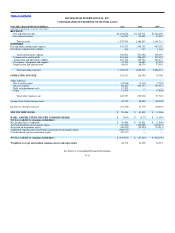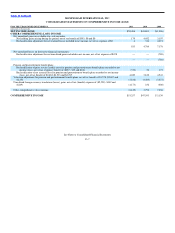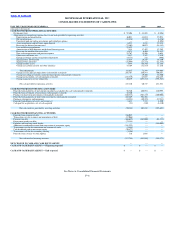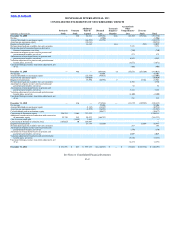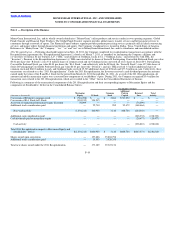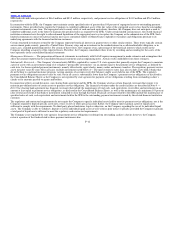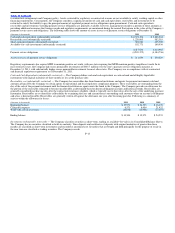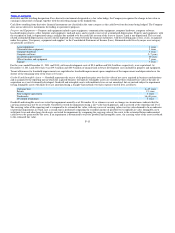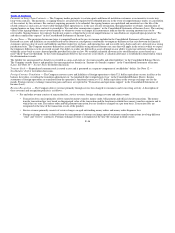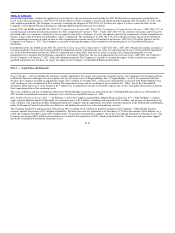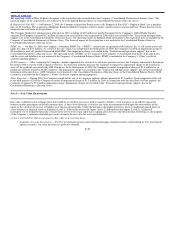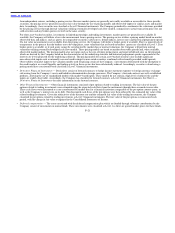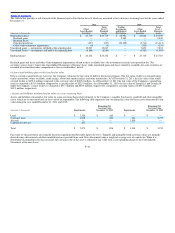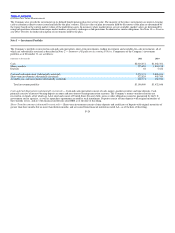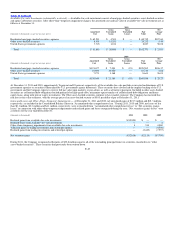MoneyGram 2011 Annual Report Download - page 98
Download and view the complete annual report
Please find page 98 of the 2011 MoneyGram annual report below. You can navigate through the pages in the report by either clicking on the pages listed below, or by using the keyword search tool below to find specific information within the annual report.
Table of Contents
Payments on Long−Term Contracts — The Company makes payments to certain agents and financial institution customers as an incentive to enter into
long−term contracts. The payments, or signing bonuses, are generally required to be refunded pro rata in the event of nonperformance under, or cancellation
of, the contract by the customer. For contracts requiring payments to be refunded, the signing bonuses are capitalized and amortized over the life of the
related contract as such costs are recoverable through future operations or, in the case of early termination, through penalties or refunds. Amortization of
signing bonuses on long−term contracts is recorded in “Fee and other commissions expense” in the Consolidated Statements of Income (Loss). The carrying
values of the signing bonuses are reviewed annually or whenever events or changes in circumstances indicate that the carrying amounts may not be
recoverable. Signing bonuses for contracts that do not require a refund in the event of nonperformance or cancellation are expensed upon payment in “Fee
and other commissions expense” in the Consolidated Statements of Income (Loss).
Income Taxes — The provision for income taxes is computed based on the pre−tax income included in the Consolidated Statements of Income (Loss).
Deferred tax assets and liabilities are recorded based on the future tax consequences attributable to temporary differences that exist between the financial
statement carrying value of assets and liabilities and their respective tax basis, and operating loss and tax credit carry−backs and carry−forwards on a taxing
jurisdiction basis. The Company measures deferred tax assets and liabilities using enacted statutory tax rates that will apply in the years in which we expect
the temporary differences to be recovered or paid. Our ability to realize our deferred tax assets depends on our ability to generate sufficient taxable income
within the carry−back or carry−forward periods provided for in the tax law. We establish valuation allowances for our deferred tax assets based on a
more−likely−than−not threshold. To the extent management believes that recovery is not likely, a valuation allowance is established in the period in which
the determination is made.
The liability for unrecognized tax benefits is recorded as a non−cash item in “Accounts payable and other liabilities” in the Consolidated Balance Sheets.
The Company records interest and penalties for unrecognized tax benefits in “Income tax (benefit) expense” in the Consolidated Statements of Income
(Loss). See Note 14 — Income Taxes for further discussion.
Treasury Stock — Repurchased common stock is stated at cost and is presented as a separate component of stockholders’ deficit. See Note 12 —
Stockholders’ Deficit for further discussion.
Foreign Currency Translation — The Company converts assets and liabilities of foreign operations to their U.S. dollar equivalents at rates in effect at the
balance sheet dates, recording the translation adjustments in “Accumulated other comprehensive loss” in the Consolidated Balance Sheets. Income
statements of foreign operations are translated from the operation’s functional currency to U.S. dollar equivalents at the average exchange rate for the
month. Foreign currency exchange transaction gains and losses are reported in “Transaction and operations support” in the Consolidated Statements of
Income (Loss).
Revenue Recognition — The Company derives revenue primarily through service fees charged to consumers and its investing activity. A description of
these revenues and recognition policies is as follows:
• Fee and other revenue consists of transaction fees, service revenue, foreign exchange revenue and other revenue.
• Transaction fees consist primarily of fees earned on money transfer, money order, bill payment and official check transactions. The money
transfer transaction fees vary based on the principal value of the transaction and the locations in which these money transfers originate and to
which they are sent. The money order and bill payment transaction fees are fixed fees charged on a per item basis. Transaction fees are
recognized at the time of the transaction or sale of the product.
• Service revenue primarily consists of service charges on aged outstanding money orders and money order dispenser fees.
• Foreign exchange revenue is derived from the management of currency exchange spreads on money transfer transactions involving different
“send” and “receive” currencies. Foreign exchange revenue is recognized at the time the exchange in funds occurs.
F−16


